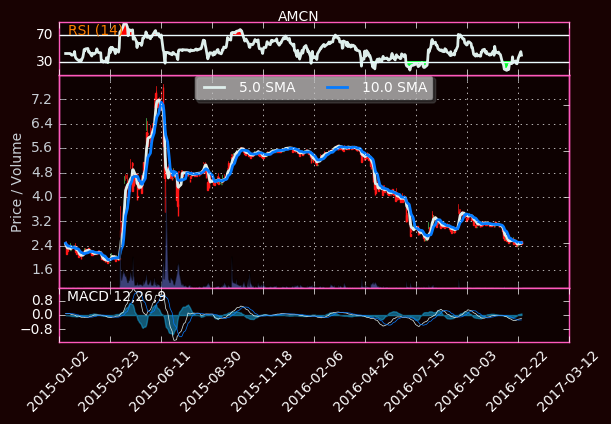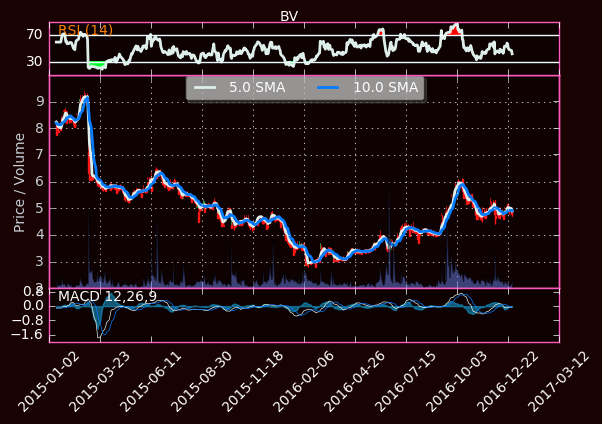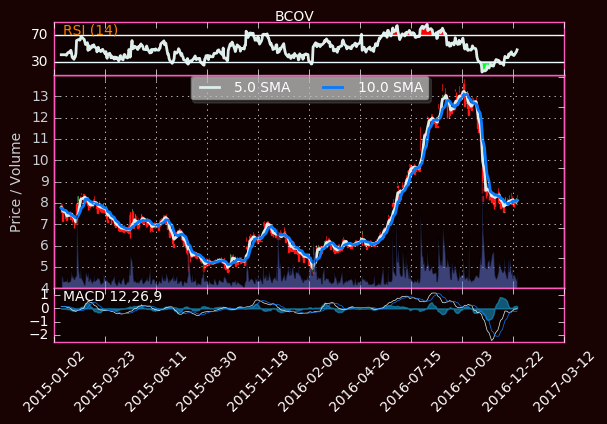Purpose
This script gathers ticker data on the tickers in the TickerList.csv file and calculates the following metrics:
- Simple moving averages
- RSI
- Exponential moving averages
- MACD
Then the tickers are filtered using the following user-defined parameters:
- MinPrice
- MaxPrice
- MinRSI
- MaxRSI
- MinVol
- MA1
- MA2
The technical charts of the tickers that meet the user-defined criteria are then displayed.
# Import libraries
import warnings
warnings.filterwarnings('ignore')
import matplotlib
import matplotlib.pyplot as plt
import matplotlib.ticker as mticker
import matplotlib.dates as mdates
from matplotlib.finance import candlestick_ohlc
matplotlib.rcParams.update({'font.size': 10})
import pylab
import numpy as np
import time
import datetime
import urllib.request
import http
# Define functions
#Define function to calculate Moving Averages
def movingAvg(data, range):
weights = np.repeat(1.0, range)/range
avg = np.convolve(data, weights, 'valid')
return avg
#Define function to calculate RSI
def rsiCalc(data, n = 14):
deltas = np.diff(data)
seed = deltas[:n+1]
up = seed[seed >= 0].sum()/n
down = -seed[seed < 0].sum()/n
rs = up/down
rsi = np.zeros_like(data)
rsi[:n] = 100. - 100. / (1. + rs)
for i in range(n, len(data)):
delta = deltas[i - 1]
if delta > 0:
upval = delta
downval = 0.
else:
upval = 0.
downval = -delta
up = (up * (n-1) + upval) / n
down = (down * (n-1) + downval) / n
rs = up / down
rsi[i] = 100. - 100. / (1. + rs)
return rsi
#Define function to calculate Exponential Moving Average
def expMovingAvg(data, range):
weights = np.exp(np.linspace(-1.,0.,range))
weights /= weights.sum()
avg = np.convolve(data, weights, mode = 'full')[:len(data)]
avg[:range] = avg[range]
return avg
#Define function to calculate MACD
def macdCalc(x, slow = 26, fast = 12):
emaslow = expMovingAvg(x, slow)
emafast = expMovingAvg(x, fast)
return emaslow, emafast, emafast - emaslow
#Define function to generate graph
def generateGraph(ticker, MA1, MA2):
#Download ticker data using Yahoo! Finance API
apiURL = 'http://chartapi.finance.yahoo.com/instrument/1.0/'+ticker+'/chartdata;type=quote;range=2y/csv'
#Create list that will store the ticker data
dataList = []
#Read and parse data
fp = urllib.request.urlopen(apiURL).read()
rawData = fp.decode("utf8")
splitData = rawData.split('\n')
for eachLine in splitData:
#Use comma as the delimiter
splitLine = eachLine.split(',')
#Ignore header
if len(splitLine) == 6:
if 'values' not in eachLine:
dataList.append(eachLine)
#Use NumPy to load data
date, closePrice, highPrice, lowPrice, openPrice, volume = np.loadtxt(dataList,delimiter = ',',unpack = True,
converters = { 0: mdates.bytespdate2num('%Y%m%d')})
#Create array to be plotted in Candlestick format
i = 0
j = len(date)
candlestickData = []
while i < j:
oneDayData = date[i], openPrice[i], closePrice[i], highPrice[i], lowPrice[i], volume[i]
candlestickData.append(oneDayData)
i += 1
#Calculate the moving averages
avg1 = movingAvg(closePrice, MA1)
avg2 = movingAvg(closePrice, MA2)
#Leave out initial data for which moving averages are not available
startingPoint = len(date[MA2-1:])
#Make plot and define face color
fig = plt.figure(facecolor = '#180202')
#Make candlestick plot
candlestickPlot = plt.subplot2grid((6,4), (1,0), rowspan = 4, colspan = 4, axisbg = '#0d0101')
candlestick_ohlc(candlestickPlot, candlestickData[-startingPoint:], width = 1, colorup = '#53C156', colordown = '#ff1717')
#Define labels for the moving averages
Label1 = str(MA1) + ' SMA'
Label2 = str(MA2) + ' SMA'
#Plot the moving averages
candlestickPlot.plot(date[-startingPoint:], avg1[-startingPoint:], '#deeeeb', label = Label1, linewidth = 2)
candlestickPlot.plot(date[-startingPoint:], avg2[-startingPoint:], '#057bff', label = Label2, linewidth = 2)
#Turn on grid
candlestickPlot.grid(True, color = 'w')
#Define max x-axis ticks
candlestickPlot.xaxis.set_major_locator(mticker.MaxNLocator(10))
#Format dates to be more readable
candlestickPlot.xaxis.set_major_formatter(mdates.DateFormatter('%Y-%m-%d'))
#Prune upper tick
plt.gca().yaxis.set_major_locator(mticker.MaxNLocator(prune = 'upper'))
#Set y-axis label color
candlestickPlot.yaxis.label.set_color('#c8cfd6')
#Set label colors
candlestickPlot.tick_params(axis = 'x', colors = '#c8cfd6')
candlestickPlot.tick_params(axis = 'y', colors = '#c8cfd6')
plt.ylabel('Price / Volume')
#Set graph border color
candlestickPlot.spines['bottom'].set_color('#ff59bd')
candlestickPlot.spines['top'].set_color('#ff59bd')
candlestickPlot.spines['left'].set_color('#ff59bd')
candlestickPlot.spines['right'].set_color('#ff59bd')
#Make legend
MALegend = plt.legend(loc = 9, ncol =2, prop = {'size': 10}, fancybox = True, borderaxespad = 0., shadow = True)
MALegend.get_frame().set_alpha(0.5)
legendText = pylab.gca().get_legend().get_texts()
pylab.setp(legendText[0:5], color = 'w')
#Add volume
minVol = 0
volPlot = candlestickPlot.twinx()
volPlot.fill_between(date[-startingPoint:], minVol, volume[-startingPoint:], facecolor = '#6b81f0', alpha = 0.5)
volPlot.axes.yaxis.set_ticklabels([])
#Set border colors
volPlot.spines['bottom'].set_color('#ff59bd')
volPlot.spines['top'].set_color('#ff59bd')
volPlot.spines['left'].set_color('#ff59bd')
volPlot.spines['right'].set_color('#ff59bd')
#Make sure volume bars do not go too high
volPlot.set_ylim(0, 2*volume.max())
#Set tick parameters
volPlot.tick_params(axis = 'x', colors = 'w')
volPlot.tick_params(axis = 'y', colors = 'w')
#Make RSI plot
rsiPlot = plt.subplot2grid((6,4), (0,0), sharex = candlestickPlot, rowspan = 1, colspan = 4, axisbg = '#0d0101')
#Calculate RSI
rsi = rsiCalc(closePrice)
posCol = '#386d13'
negCol = '#8f2020'
rsiPlot.plot(date[-startingPoint:],rsi[-startingPoint:], '#deeeeb', linewidth = 2)
#Make horizontal lines at ris = 70 and rsi = 30 to represent overbought and oversold points
rsiPlot.axhline(70, color = '#eafbff')
rsiPlot.axhline(30, color = '#eafbff')
#Fill overbought and oversold conditions
rsiPlot.fill_between(date[-startingPoint:],rsi[-startingPoint:],70, where = rsi[-startingPoint:] >= 70, facecolor = '#ff0000', edgecolor = '#ff0000')
rsiPlot.fill_between(date[-startingPoint:],rsi[-startingPoint:],30, where = rsi[-startingPoint:] < 30, facecolor = '#00ff2b', edgecolor = '#00ff2b')
#Set title of graph
rsiPlot.text(0.018, 0.98, 'RSI (14)', va = 'top', color = '#FF8000', transform = rsiPlot.transAxes)
#Set border color
rsiPlot.spines['bottom'].set_color('#ff59bd')
rsiPlot.spines['top'].set_color('#ff59bd')
rsiPlot.spines['left'].set_color('#ff59bd')
rsiPlot.spines['right'].set_color('#ff59bd')
#Set tick parameters
rsiPlot.tick_params(axis = 'y', colors = 'w')
rsiPlot.tick_params(axis = 'x', colors = 'w')
rsiPlot.set_yticks([30, 70])
rsiPlot.yaxis.label.set_color('w')
#Make MACD plot
macdPlot = plt.subplot2grid((6,4), (5,0), sharex = candlestickPlot, rowspan = 1, colspan = 4, axisbg = '#0d0101')
#Define MACD parameters
slow = 26
fast = 12
ema = 9
#Calculate MACD and Exponential Moving Average
emaslow, emafast, macd = macdCalc(closePrice)
ema9 = expMovingAvg(macd, ema)
#Plot data
macdPlot.plot(date[-startingPoint:], macd[-startingPoint:], color = '#deeeeb', lw = 0.5)
macdPlot.plot(date[-startingPoint:], ema9[-startingPoint:], color = '#057bff', lw = 0.5)
macdPlot.fill_between(date[-startingPoint:], macd[-startingPoint:] - ema9[-startingPoint:], 0, alpha = 0.5, facecolor = '#17aee7', edgecolor = '#17aee7')
#Add chart title
macdPlot.text(0.017, 0.98, 'MACD 12,26,9', va = 'top', color = 'w', transform = macdPlot.transAxes)
#Set border color
macdPlot.spines['bottom'].set_color('#ff59bd')
macdPlot.spines['top'].set_color('#ff59bd')
macdPlot.spines['left'].set_color('#ff59bd')
macdPlot.spines['right'].set_color('#ff59bd')
#Define tick parameters
macdPlot.tick_params(axis = 'x', colors = 'w')
macdPlot.tick_params(axis = 'y', colors = 'w')
macdPlot.yaxis.set_major_locator(mticker.MaxNLocator(nbins = 5, prune = 'upper'))
#Set bottom graph x labels as 45 degrees
for label in macdPlot.xaxis.get_ticklabels():
label.set_rotation(45)
#Set ticker as title of all graphs
plt.suptitle(ticker, color = 'w')
#Hide x labels of other plots
plt.setp(candlestickPlot.get_xticklabels(), visible = False)
plt.setp(rsiPlot.get_xticklabels(), visible = False)
#Adjust the spacing of the graphs
plt.subplots_adjust(left = .1, bottom = .15, right = .95, top = .95, wspace = .20, hspace = 0)
#Show plot
plt.show()
# Define paramaters
MinPrice = 1
MaxPrice = 10
MinRSI = 0
MaxRSI = 50
MinVol = 100000
MA1 = 5.0
MA2 = 10.0
#Open and read ticker file
TickerReader = open('TickerList.csv','r').read()
splitTickers = TickerReader.split('\n')
for ticker in splitTickers:
#Download ticker data using Yahoo! Finance API
apiURL = 'http://chartapi.finance.yahoo.com/instrument/1.0/'+ticker+'/chartdata;type=quote;range=2y/csv'
#Create list that will store the ticker data
dataList = []
#Read and parse data
try:
fp = urllib.request.urlopen(apiURL).read()
rawData = fp.decode("utf8")
splitData = rawData.split('\n')
for eachLine in splitData:
#Use comma as the delimiter
splitLine = eachLine.split(',')
#Ignore header
if len(splitLine) == 6:
if 'values' not in eachLine:
dataList.append(eachLine)
if len(dataList) > 200:
#Use NumPy to load data
date, closePrice, highPrice, lowPrice, openPrice, volume = np.loadtxt(dataList,delimiter = ',',unpack = True,
converters = { 0: mdates.bytespdate2num('%Y%m%d')})
#Calculate RSI and average volume
RSI = rsiCalc(closePrice)
avgVol = sum(volume) / len(volume)
#Run filter and generate graph
if closePrice[-1] > float(MinPrice) and closePrice[-1] < float(MaxPrice) and RSI[-1] > float(MinRSI) and RSI[-1] < float(MaxRSI) and float(avgVol) > float(MinVol):
generateGraph(ticker, MA1, MA2)
except:
pass






